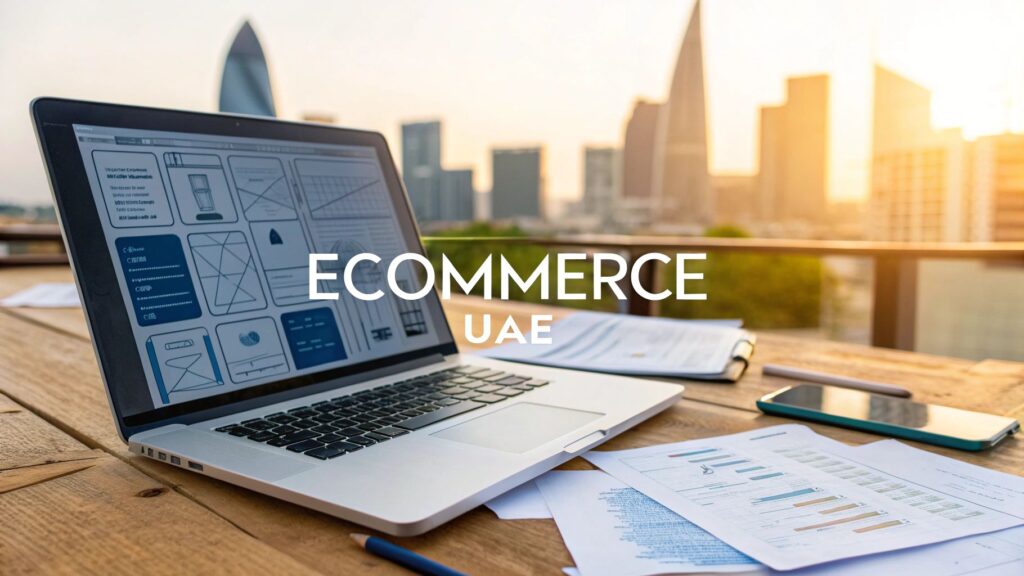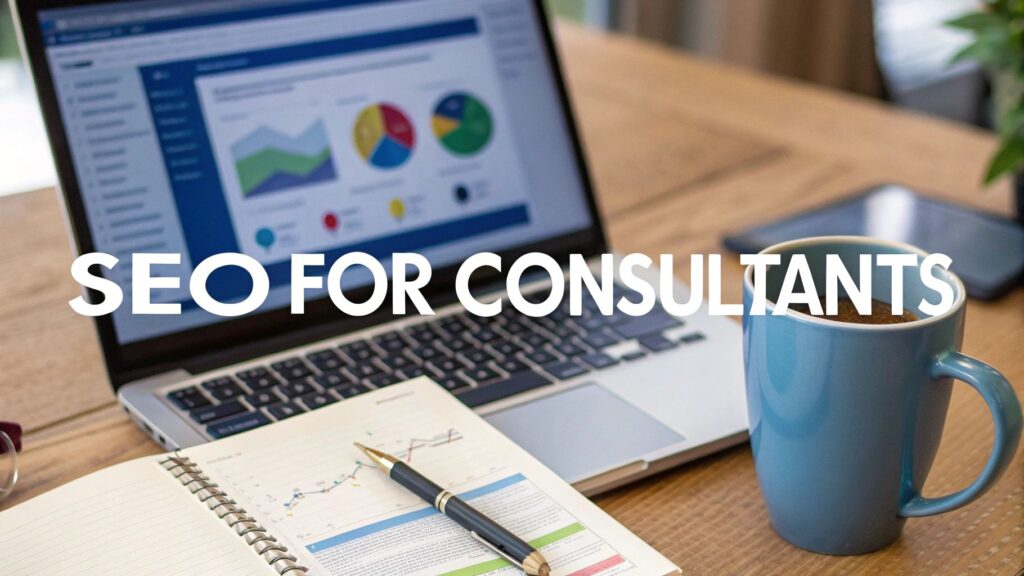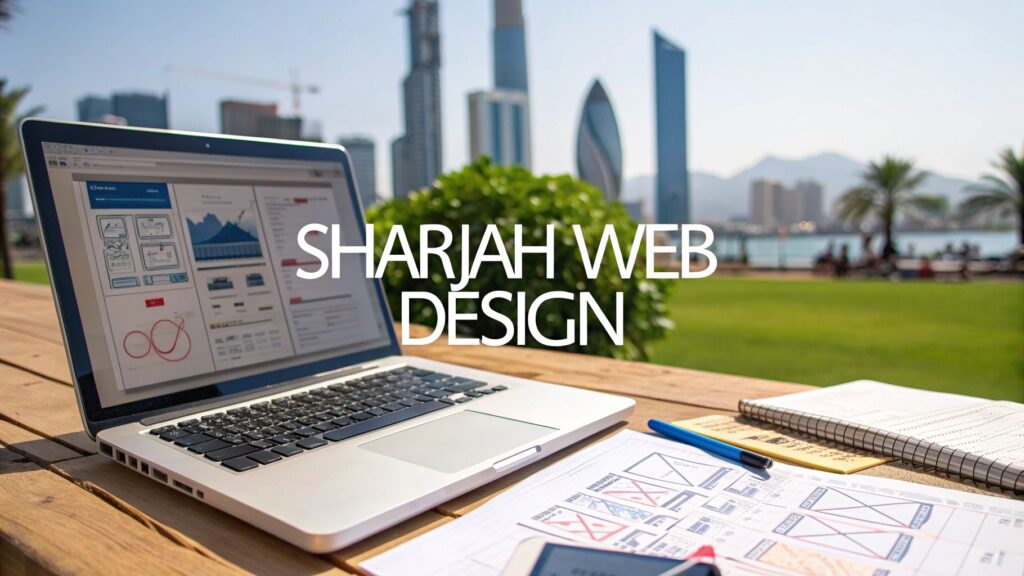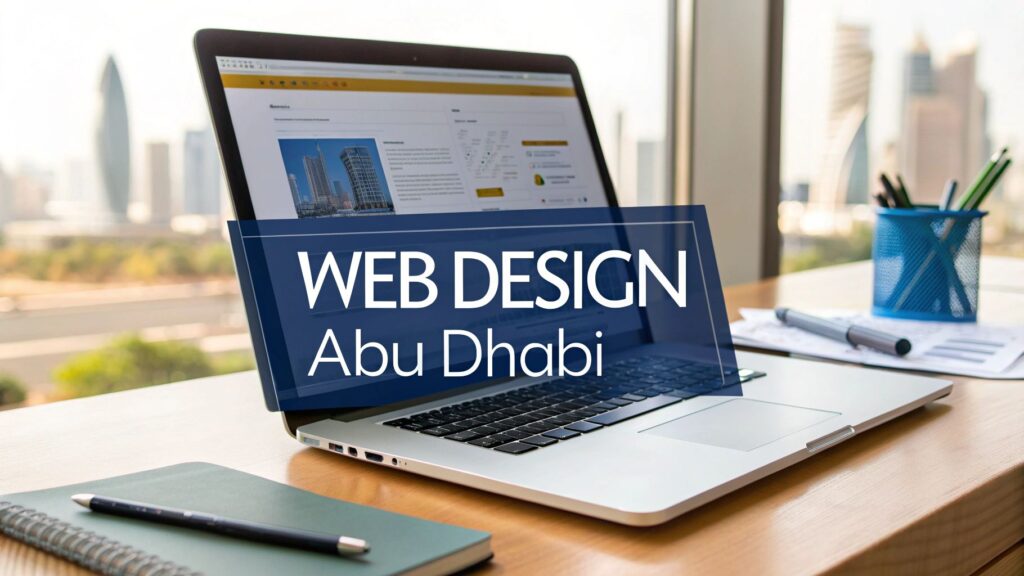A great ecommerce website design uae isn’t just about a slick look and feel. The real magic happens long before you even think about colours or fonts. It all starts with a rock-solid strategy built from the ground up, specifically for the nuances of the UAE market.
If you don’t know who you’re selling to and what your competitors are doing, you’re essentially flying blind.
Building Your Foundation for UAE Ecommerce Success
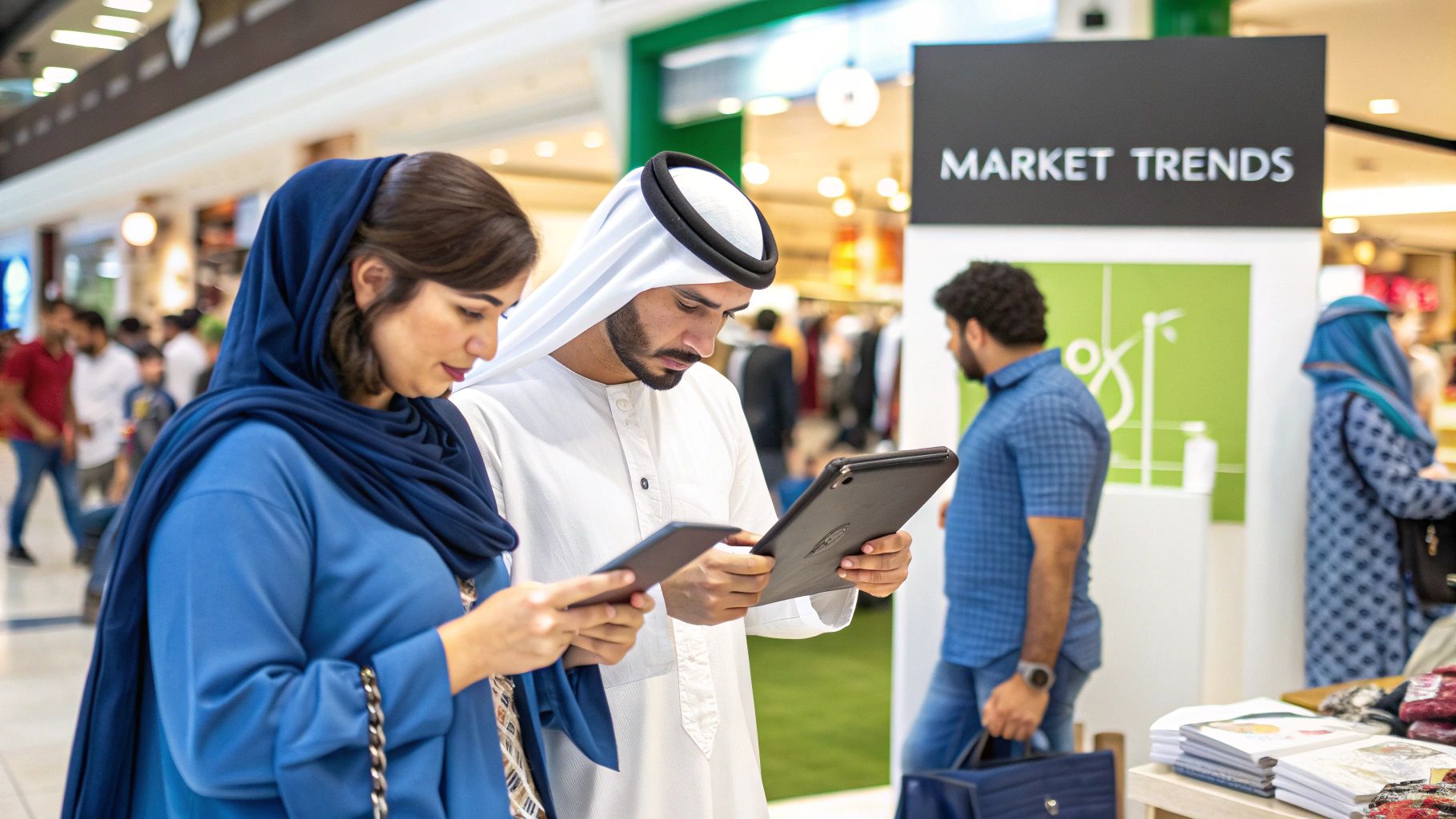
I’ve seen it countless times: businesses get excited and jump straight into design, only to wonder why sales aren’t coming in. In a market as competitive as the UAE, that’s a recipe for failure. The first, most crucial phase is all about rolling up your sleeves and doing the homework: deep market research, carving out your unique niche, and getting inside the heads of your future customers.
This groundwork is what makes the difference. It ensures every design choice, every feature, and every marketing message actually connects with real people. It turns a simple online catalogue into a finely tuned sales engine, giving you a serious advantage from day one.
Pinpointing Your Target Audience
So, who are you really selling to? A vague answer like “everyone in the UAE” is the fastest way to sell to no one. The UAE is incredibly diverse. Your customer could be an Emirati national who values luxury and culturally-aware messaging, a Western expat looking for familiar brands and a seamless online experience, or even a tourist hunting for unique local gifts.
Each of these groups has completely different expectations:
- Emirati Nationals: They often look for Arabic language options, culturally sensitive imagery, and are big fans of Cash on Delivery (COD) or local buy-now-pay-later services.
- Expatriates: They’re used to world-class e-commerce. They expect flawless English interfaces, straightforward credit card payments, and clear, fast delivery timelines.
- Tourists: They’re probably looking for souvenirs. For them, crystal-clear international shipping policies and multi-currency displays are non-negotiable.
Nailing down your primary audience dictates everything—from the languages you offer to the style of your product photography. This foundation is a key part of the broader conversation around professional website development services, connecting your business goals directly to the technical build.
Conducting Incisive Competitor Analysis
Once you know your customer, it’s time to put your competition under the microscope. Don’t just make a list. You need to dissect their entire online operation. And I don’t just mean the big players like Noon and Amazon.ae; look for the niche competitors in your specific category who are probably doing some things very well.
Your goal is to find their strengths, but more importantly, their weaknesses. These gaps are where your opportunity lies. I always advise clients to open a simple spreadsheet and track a few key elements for each competitor.
Pro Tip: Don’t just browse their site—become a customer. Add an item to your cart, go all the way through the checkout process, and see what it’s really like. Note every frustrating step or confusing message. Those friction points are your golden opportunities to create a better experience.
Deconstructing the Competition
As you analyse, focus on these areas to find your competitive edge:
- The User Journey: Is their site easy to navigate on both desktop and mobile? Can you find a specific product in just a couple of clicks? A clunky search bar is a common weakness you can easily beat.
- Payment Options: Are they offering Tabby and Tamara? Is COD an option? A lack of flexible payment methods is one of the biggest reasons for abandoned carts in the UAE.
- Delivery Promises: What are their shipping times and costs to different Emirates like Dubai versus Abu Dhabi? See if you can offer something faster or cheaper.
- Unique Selling Proposition (USP): What’s their hook? Is it rock-bottom prices, exclusive products, or amazing customer service? Figure out their core appeal so you can position your brand to offer something different and better.
This deep dive gives you a clear roadmap. It shows you where the bar is set and, more importantly, exactly where you can raise it. Getting this strategy right is vital, especially when you consider the sheer size of the prize. The UAE’s e-commerce market is a regional powerhouse, forecasted to be worth between $17 to $20 billion (AED 63–74 billion) by 2025. With nearly universal internet access, you’re tapping into a massive, tech-savvy audience.
Designing a User Experience That Converts UAE Shoppers
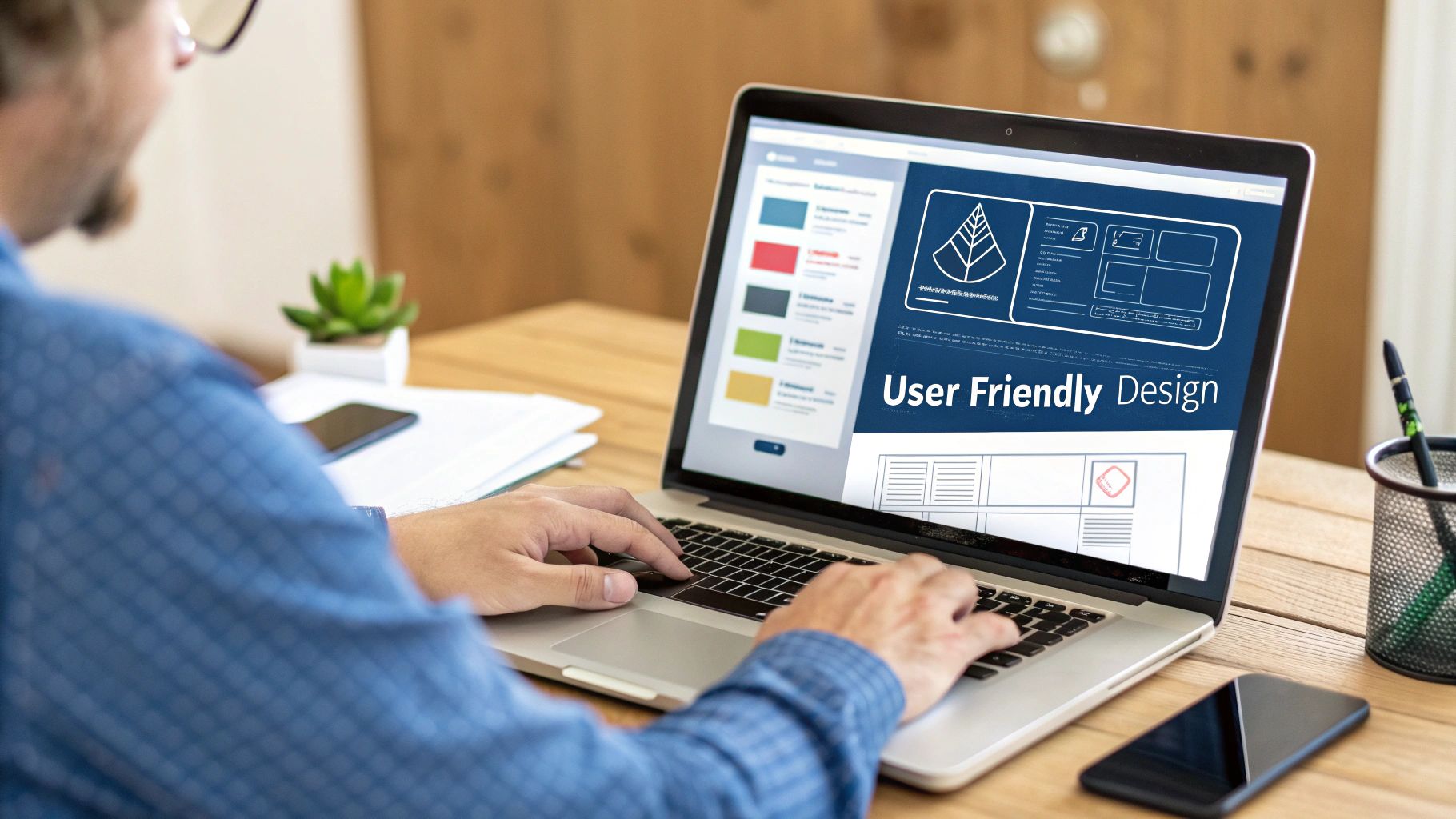
In the UAE, your website’s user experience (UX) is about more than just a pretty layout—it’s the very foundation of customer trust. Shoppers here have incredibly high standards, shaped by their interactions with global luxury brands and world-class digital services. A generic, off-the-shelf theme just won’t make the cut.
To really connect, your ecommerce website design in the UAE has to feel premium, intuitive, and completely seamless. It’s about crafting an online space that feels exclusive, secure, and effortless, turning casual browsers into devoted customers.
Embrace Clean Aesthetics and Striking Visuals
First impressions are final. The UAE market has a strong appetite for luxury and high-end experiences, so clean, uncluttered design is what resonates. Think of your website as a digital boutique: spacious, well-lit, and with an undeniable focus on the product.
A strong visual hierarchy is your best friend here. It’s all about using size, colour, and placement to subtly guide a visitor’s eye towards the most important things, like the “Add to Cart” button or a flash sale banner. You want the shopping journey to feel instinctual, not like a puzzle.
The real goal is to reduce cognitive load. When customers don’t have to think hard about where to click or how to find a product, they are far more likely to stick around and make a purchase. Simplicity breeds confidence.
This demand for top-tier aesthetics is driving serious growth. In fact, the graphic design industry in the UAE, which fuels great web visuals, is projected to be worth AED 2.4 billion by 2025. This shows just how much businesses are investing in sophisticated, engaging design that converts.
Prioritise a Flawless Mobile-First Experience
Let’s be clear: in the UAE, “mobile-first” isn’t a buzzword; it’s a commercial necessity. The vast majority of online shopping happens on a smartphone, which means your site has to be built for the small screen from day one. This is so much more than a responsive layout that simply shrinks to fit.
A true mobile-first approach means rethinking the entire experience for a touch interface.
- Thumb-Friendly Navigation: Are your main buttons and menus easy to reach with one hand?
- Simplified Forms: Keep checkout and sign-up forms short and sweet. No one wants to type a novel on their phone.
- Optimised Images: Product photos must load lightning-fast without looking pixelated, especially for users on mobile data.
- Tap-Happy Targets: Make sure all links and buttons are big enough to be tapped accurately, avoiding frustrating mis-clicks.
Failing to get this right is like shutting your doors to over 80% of your potential customers. The experience has to feel just as polished and professional on a phone as it does on a desktop.
Craft Product Pages That Tell a Story
Think of your product pages as your digital sales associates. Their job isn’t just to list specs; it’s to tell a compelling story that creates desire and builds trust. High-quality, magazine-style photography is absolutely non-negotiable.
Show your products from every conceivable angle, in a real-world context, and use video whenever you can. For a dress, show a model walking in it. For a watch, use a close-up to highlight the craftsmanship. These visuals are critical for bridging the gap since customers can’t physically touch the item.
Pair those stunning images with clear, persuasive copy. Use bullet points for the key benefits and write detailed descriptions that anticipate and answer a customer’s questions. The more information and confidence you provide, the closer you are to making that sale.
Integrating the Right Features for the UAE Market
A slick-looking e-commerce website is a great start, but in the UAE, it’s what’s under the bonnet that really counts. A high-performance site here is an engine, finely tuned with features that meet local expectations head-on. Once you’ve nailed the design and user experience, the specific functionalities you build in are what will actually drive sales and keep customers coming back.
From language to logistics, every choice matters. These aren’t just nice-to-have add-ons; they are core components for anyone serious about succeeding in this market.
This whole process is about creating a truly local feel—a blend of language, culture, and commerce that feels natural to your customers.
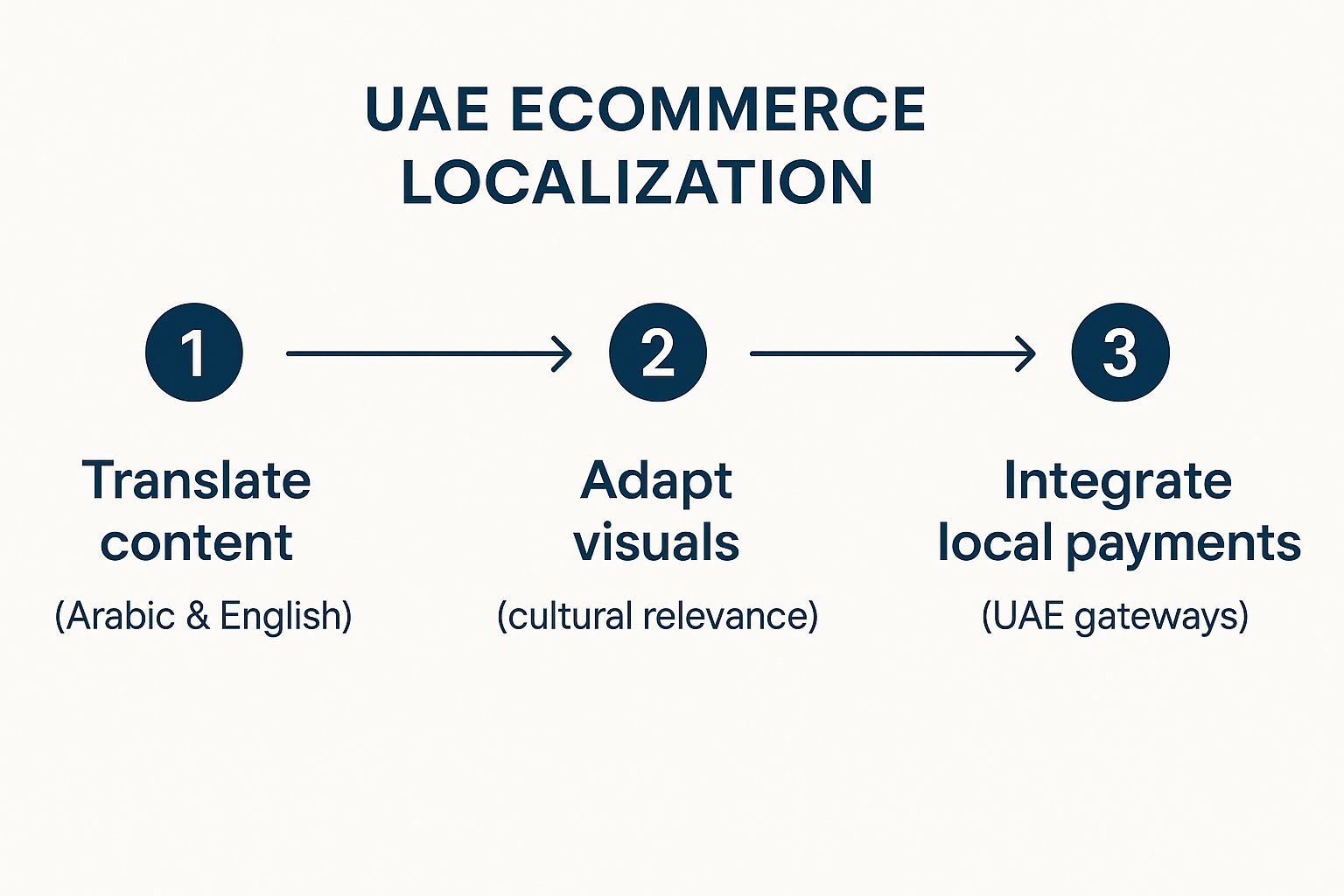
Implement Flawless Bilingual Support
The UAE is a melting pot of cultures, but Arabic is the official language and sits at the heart of its identity. For any serious e-commerce business, offering your entire website in both English and Arabic isn’t optional—it’s essential. And this goes way beyond just translating a few product titles.
To get it right, your bilingual setup needs to cover a few bases:
- Complete Content Translation: We’re talking everything. Product descriptions, navigation, privacy policies, and even the tiny text in your checkout process.
- Right-to-Left (RTL) Layout: Arabic reads from right to left. Your website’s entire design needs to flip to accommodate this naturally. A professional e-commerce website design for the UAE plans for this from day one.
- Culturally Smart Copy: Word-for-word translation rarely works. Your marketing slogans and calls to action must be adapted so they resonate culturally in both languages.
Getting this right instantly broadens your reach, shows you respect the local culture, and makes your brand far more accessible.
Offer the Payment Gateways Shoppers Actually Use
How your customers pay is just as important as what they’re buying. Credit cards are common, but a huge slice of the market prefers and trusts local payment methods. If you don’t offer them, you’re practically turning away sales.
Integrating local payment options isn’t just a technical task; it’s a powerful trust signal. When customers see familiar and preferred payment methods like Tabby or Cash on Delivery, their confidence in your brand skyrockets, dramatically reducing cart abandonment.
Your payment gateway absolutely must include these options:
- Buy Now, Pay Later (BNPL): Services like Tabby and Tamara are incredibly popular. They let customers split payments into interest-free instalments, which makes bigger-ticket items feel much more affordable.
- Cash on Delivery (COD): Even with the digital boom, COD is still a go-to for many shoppers. They value the security of seeing the product before they part with their cash.
- Local Debit Cards: Make sure your payment gateway smoothly accepts local card schemes. Don’t let a simple transaction fail because of incompatibility.
Connecting these services usually means working with APIs. If that term is new to you, it’s a good idea to understand what API integration is and how it allows these different systems to “talk” to your website.
To make the right choice, you need to know what to look for.
UAE Payment Gateway Feature Checklist
When you’re vetting potential payment gateway providers, it’s easy to get lost in the technical jargon. This checklist breaks down the essential features you need for the UAE market, helping you cut through the noise and choose a partner that truly supports your business goals.
| Feature | Why It Matters in the UAE | Example Providers |
|---|---|---|
| BNPL Integration | Essential for increasing conversions on higher-priced goods. Incredibly popular with younger, tech-savvy shoppers. | Tabby, Tamara |
| Cash on Delivery (COD) | Builds trust with first-time buyers and those who prefer not to share card details online. A non-negotiable for many. | Pay-on-delivery services offered by couriers like Aramex |
| Multi-Currency Support | Critical for a hub like the UAE. Allows you to display prices and accept payments in AED, USD, and other key currencies. | Stripe, Checkout.com, Telr |
| High Security & PCI DSS | Protects your customers’ sensitive data and your business from fraud. Builds crucial brand credibility. | Most reputable gateways (e.g., Stripe, Telr) are compliant |
| Easy API Integration | A well-documented API makes it simpler for your developers to connect the gateway to your store, saving time and money. | Stripe, Checkout.com |
| Mobile-Optimised Checkout | With most shoppers buying on their phones, the payment process must be flawless on a small screen to avoid drop-offs. | All modern gateways should offer this |
Choosing a gateway isn’t just about transaction fees. It’s about finding a partner whose features align perfectly with the expectations and habits of your UAE customers.
Streamline Your Logistics and Delivery
In the UAE, delivery isn’t an afterthought—it’s a massive part of the customer experience. Expectations are sky-high. Shoppers want speed, clear communication, and total reliability. A vague “ships in 3-5 working days” just won’t fly here.
First things first, you need to set clear delivery costs and timelines for all seven Emirates. Shipping to downtown Dubai is a world away from delivering to a remote area in Ras Al Khaimah, and your logistics plan needs to account for that.
The real game-changer is integrating your store directly with local couriers like Aramex, Fetchr, or Shipa. This connection provides real-time order tracking, which customers now expect as standard. They want to know precisely where their package is and when it will land on their doorstep. That level of transparency builds incredible trust and takes a huge load off your customer service team.
This focus on a smooth back-end is even more critical when you consider the region’s shopping habits. A mobile-first design is a must, as more than 80% of online shoppers in the UAE make purchases on their smartphones. With 72% of all internet traffic in the country coming from mobile devices, every single feature—from payment to delivery tracking—has to work perfectly on a smaller screen.
Making Sure Your Customers Can Actually Find You
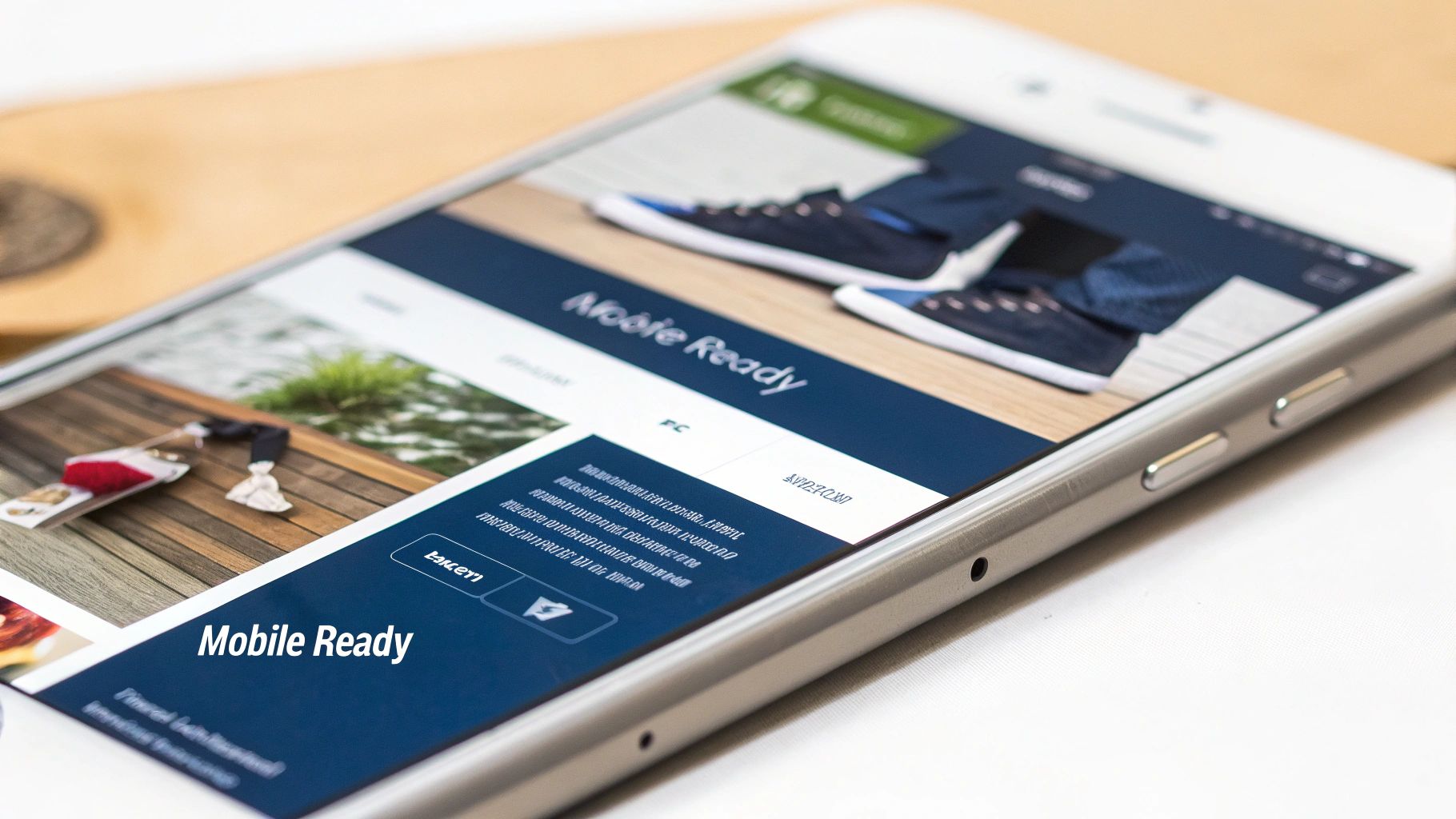
Here’s the hard truth: a stunning, feature-packed website is useless if no one sees it. Getting your store live is just the beginning. The real work starts with mastering Search Engine Optimisation (SEO) to bring in a consistent flow of shoppers. In the UAE, that means having a sharp strategy that understands both language and location.
Your goal is simple. You want to be the first name people see when they search for what you sell. This isn’t about chasing random keywords; it’s about connecting with people who have their wallets out, actively looking for your products. A solid SEO plan is a core part of a successful ecommerce website design in the UAE, transforming your site from a digital brochure into a customer magnet.
Digging for Gold: Bilingual Keyword Research
Before you do anything else, you need to get inside your customers’ heads and figure out exactly what they’re typing into Google. In the UAE, this research has to be bilingual right from the get-go. You’re not just translating phrases from English to Arabic—you’re uncovering completely different search habits and intentions.
Think about it. An English speaker might search for “luxury abaya online,” but an Arabic speaker is more likely to use “أفخم عبايات أونلاين”. They aren’t direct translations, and they capture different cultural nuances.
Fire up your favourite keyword research tool and start exploring the search volumes and competition for both languages. Keep a close eye on these three types:
- Transactional Keywords: These signal a clear intent to buy. Think “buy iPhone 15 Dubai” or “delivery groceries Abu Dhabi.” These are your money-makers.
- Informational Keywords: This is where people are doing their homework, asking things like “best coffee beans for Arabic coffee.” Creating helpful content around these positions you as an expert.
- Local Keywords: Hyper-specific phrases like “same-day flower delivery Sharjah” are absolute gold for capturing local buyers.
By tackling both languages, you make sure you’re visible to everyone in your market, not just a small slice of it.
Getting Your Pages in Order with On-Page SEO
Once you’ve got your target keywords, it’s time to weave them into the fabric of your website. Every single product and category page is a new chance to rank. Start by optimising these key elements.
- URL Structures: Your URLs should be clean and make sense.
yourstore.ae/womens-fashion/kaftansis infinitely better for SEO than a jumbled mess likeyourstore.ae/cat/prod?id=123. - Meta Titles & Descriptions: This is your elevator pitch on Google’s results page. The title is the clickable blue link, and the description is the text underneath. Make them compelling and include your keywords to convince people to click on your link, not your competitor’s.
- Product Descriptions: Write unique, detailed, and persuasive descriptions for every single item. Never, ever just copy and paste the manufacturer’s text. This is your chance to tell a story and naturally include your keywords.
- Header Tags (H1, H2, H3): Use headers to give your content structure. Your main page title goes in an H1 tag, with subheadings in H2s and H3s. This simple trick helps both users and search engines quickly understand what your page is all about.
On-page SEO boils down to two things: clarity and relevance. You’re giving search engines a clear roadmap of your site’s content while giving your visitors a better, more helpful experience. When you get that combination right, your rankings will follow.
Your Secret Weapon for Local Search: Google Business Profile
If your e-commerce business has any kind of physical footprint—a warehouse, a showroom, even just a head office—then setting up a Google Business Profile (GBP) is non-negotiable. Think of it as your digital storefront on Google Search and Maps.
A well-managed GBP listing can get you into the “Local Pack” map results, that coveted spot at the top of the search page. This is prime digital real estate, especially for mobile users searching for businesses “near me.”
Make sure your profile is 100% complete and accurate. We’re talking business name, address, phone number, and opening hours. And don’t be shy about asking happy customers to leave reviews; those five-star ratings are a massive trust signal that can seriously boost your local authority.
SEO is a huge field, but understanding how the different pieces fit together is the key to growth. To dig deeper, check out our guide that explains what search engine marketing is and how it all works in practice.
Getting the Legal Side Right and Earning Customer Trust
Setting up an e-commerce shop in the UAE is about more than a slick design and a killer marketing plan. You have to get a handle on the local laws. Honestly, this isn’t just about ticking boxes for the government; it’s the foundation of your entire relationship with your customers. Shoppers here are savvy, and they won’t even think about buying if they don’t feel secure.
Skipping these crucial steps can land you in hot water legally, and worse, it can torpedo your brand’s reputation before you even get started. Nailing this part of your ecommerce website design uae plan is non-negotiable if you’re in it for the long haul.
Getting the Right Trade Licence
First things first: you can’t legally sell anything online in the UAE without a trade licence. This is your official green light to do business, and the specific one you need hinges on your business setup and where you’re based.
For a lot of new entrepreneurs, especially if you’re a sole proprietor working from your home in Dubai, the e-trader licence is a fantastic and affordable way to get going. It’s specifically designed for individuals.
If you’re planning something bigger or holding physical stock, you’ll likely need to look at a mainland or a free zone licence. Each comes with its own rulebook on ownership, what you’re allowed to sell, and office space requirements. Taking the time to figure out which one fits your vision is a critical first move.
I always tell clients to think of their trade licence as their business’s passport. Without it, you can’t operate legally or open a corporate bank account, which you absolutely need to link up with any payment gateway. Getting this sorted from day one saves you from massive headaches later on.
Writing Clear, Compliant Website Policies
Those legal pages on your website? They aren’t just there to fill space. They’re actual legal documents that protect you and your customers. In my experience, UAE shoppers will bounce right off a site with vague or missing policies—it’s a huge red flag that screams “unprofessional.”
To build that crucial confidence, your website absolutely must have these three policies. Make them easy to find and write them in plain English, not legal jargon.
- Privacy Policy: This needs to spell out exactly what customer info you collect (names, addresses, browsing data), what you do with it, and how you protect it. Be completely transparent here.
- Terms & Conditions: This is the rulebook for using your site. It should cover everything from how you take payments and who owns the content to your limits of liability.
- Returns & Refunds Policy: Be incredibly clear about your process for returns and refunds. What’s the timeframe? What condition must the item be in? Who pays for the return shipping? Any grey areas here are a recipe for customer disputes.
Making Security a Priority with SSL and Safe Payments
I’ve seen it happen time and again: nothing kills customer trust faster than a security scare. Shoppers in the UAE are very aware of online risks and will drop their cart in a second if a site feels unsafe. This is where the technical side of your design becomes absolutely critical.
An SSL (Secure Sockets Layer) certificate is the bare minimum. It encrypts the connection between your customer’s browser and your site, protecting their passwords and credit card numbers. You know a site has it when you see that little padlock icon and “https://” in the address bar.
Beyond that, you have to partner with a reputable payment gateway that is PCI DSS compliant. These companies follow incredibly strict security rules to make sure every transaction is handled safely. Don’t be shy about showing off their logos on your checkout page; it’s a simple move that can really boost conversions by telling customers their money is in safe hands.
Answering Your Top Questions About UAE Ecommerce Websites
When you’re first diving into the UAE’s digital market, a lot of the same questions tend to pop up. Let’s get them answered with some straight, practical advice to help you build your online store with a bit more confidence.
How Much Will an Ecommerce Website Cost in the UAE?
This is always the first question, and the honest answer is: it depends. The cost for an ecommerce website design in the UAE can be anything from a few thousand dirhams for a straightforward site using a pre-built template, all the way up to AED 100,000+ for a deeply customised platform with all the bells and whistles.
The final price really comes down to a few critical things:
- Your Platform: Getting started with a Shopify template is almost always cheaper upfront than building a custom site on a more complex platform like Magento.
- Design Uniqueness: If you want a one-of-a-kind design with custom graphics and interactive elements, expect that to cost more than a clean, standard layout.
- Custom Features: Every extra function you add—think advanced product filters, a loyalty programme, or connecting to your inventory system—adds development time and, therefore, cost.
- Going Bilingual: A flawless Arabic version isn’t just a translation. It requires specialised right-to-left (RTL) coding and design work, which will factor into the budget.
I always tell clients to think of it like building a house. You can go with a cost-effective pre-designed plan, or you can hire an architect for a custom design with high-end finishes. Both get you a house, but the investment is worlds apart.
Which Ecommerce Platform Is Best for a Business Here?
There’s no single “best” platform for everyone. It’s all about what’s best for your business.
For most small and medium-sized businesses just starting out, Shopify and WooCommerce are fantastic. They strike a great balance between being easy to use, able to grow with you, and having a huge library of apps for localising your store for the UAE.
On the other hand, if you’re a larger enterprise with thousands of products and very specific needs, something like Magento or even a completely custom-built solution might be the better long-term fit. They give you ultimate control but come with a much steeper learning curve and higher development costs.
My advice? Start with a platform that lets you get to market quickly and efficiently. You can always add more complex features as your business grows and your revenue justifies the investment.
Do I Really Need to Offer Cash on Delivery?
In a word: yes. While digital payments are growing fast, Cash on Delivery (COD) is still king in the UAE. It’s a payment method people here know and trust. For many shoppers, especially if they’re buying from a new brand, the ability to physically see the product before parting with their money is a huge deal.
Skipping COD can directly lead to a ton of abandoned carts. It’s not just another payment option; it’s a fundamental tool for building that initial trust with your customers. Make sure you find a reliable local courier who can handle cash collections as part of your core logistics plan.
How Important Is an Arabic Version of My Site?
It’s absolutely critical. English is spoken everywhere, but offering a full Arabic version of your website is a sign of respect for the local culture. It makes your brand instantly more welcoming and accessible to a massive part of the population. Arabic is the official language, and people naturally prefer to shop in their native tongue.
And this goes beyond just a simple translation. A proper Arabic site needs a full right-to-left (RTL) design overhaul. Everything from the text and images to the navigation menus needs to be flipped to feel intuitive. Investing in professional translation and a proper RTL design shows you’re serious about the UAE market, which will do wonders for your credibility and sales.
At Invocom, we live and breathe ecommerce in the UAE. We build high-performance online stores, from streamlined Shopify sites to complex system integrations, that are perfectly tuned for what local shoppers expect. Start building your future with us today.

